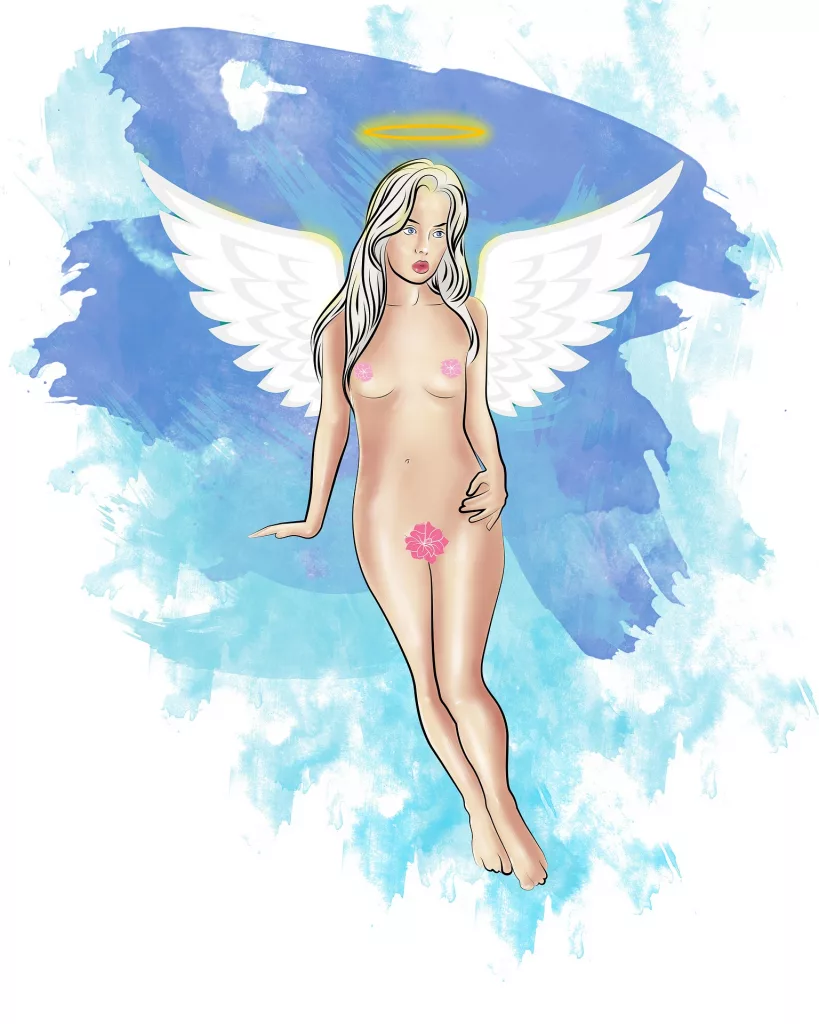Table of Contents
Vaginitis, also known as vaginal infection and vulvovaginitis, is an inflammation of the vagina or the vaginal walls causing, in some cases, an abnormal vaginal discharge not attributable to cervicitis which is an inflammation of the cervix. It is a form of infection of the vagina which needs to be treated properly.
The vagina is a musculomembranous canal extending from the cervix to the vulva; it measures 8 to 12 centimeters in length. The top of its cavity is occupied by the protrusion of the cervix, which surrounded by a sleeve called cul-de-sac, rectouterine pouch, rectouterine excavation, rectovaginal or Pouch of Douglas. Its lower end is separated from the vulva by a membrane called hymen, which is torn during the first sexual intercourse and replaced after first childbirth by the carunculae myrtiformes. The vaginal wall, flexible and contractile, forms longitudinal and transverse folds very scalable that allow sexual intercourse and passage of the fetus during delivery. The cavity of the vagina is moisturized by a whitish creamy substance secreted by the vaginal cells and the cervical mucus.
Vaginal Infection Causes

Vaginitis can be non-infectious or infectious.
Non-infectious Vaginitis – non-infectious vaginitis are often the result of an allergy, irritation or drying of the vagina walls. Spermicides, some sanitary napkins, douches, detergents, fabric softeners and latex condoms can all irritate the vaginal lining and leads to inflammation of the vagina. Atrophic vaginitis is one of the common forms of non infectious vaginitis.
Atrophic vaginitis – This form of non infectious vaginitis occurs mainly during menopause. A lack of hormonal secretion is often the source of the problem. Menopause tends decrease the secretion or concentration of estrogen hormones. In some menopausal women, this hyposecretion leads to a thinning or irritation of the vaginal lining. Without an appropriate hormone replacement therapy, the disorder will eventually cause vaginitis and/or other vaginal issues.
Infectious vaginitis – infectious vaginitis are caused by bacteria, viruses, fungi or parasites. The most common types of infectious vaginitis are vaginal yeast infection (candida vaginitis), bacterial vaginosis and trichomoniasis (trichomonas infection).
Candida vaginitis (yeast infection) – commonly called vaginal yeast infection, candida vaginitis affects approximately 5% of women during their lives. The infection is usually caused by the fungus candida albicans. Candida albicans is normally found on the mucous membranes of the digestive tract and the vagina and are considered as part of the physiological vaginal flora. They become a health problem when there is an uncontrolled proliferation due to certain factors such as:
- Taking too much antibiotics
- Eating food rich in sugar
- Regular use of vaginal douching
- Having a weekend immune system.
Bacterial vaginosis – bacterial vaginosis is the most common form of vaginal infections. It is estimated that the infection is account for nearly 50% of all types of vaginitis. It is more common among polygamous women or those who often change partner. bacterial vaginosis is characterized by excessive proliferation of bacteria in the vaginal environment.
The vagina naturally host a multitude of bacteria, one of them is called lactobacillus. The main role of lactobacillus is to maintain a normal level of acidity in the vagina and prevents proliferation of pathogenic organisms. Some factors, however, can lead to a significant decrease of lactobacilli and an overgrowth of harmful bacteria. This imbalance causes the vagina to become inflamed and emits a bad odor. Factors that may lead to an overgrowth of bacteria in the vagina include:
- Menopause
- STDs including HIV
- Chronic diseases
- Immune disorders
- Taking high dose of oral contraceptives containing estrogen
- Chemicals such as douching, perfumed toiletries
- Some Irradiations such as radiotherapy treatment, cytostatic treatment
- Taking antibiotics with broad spectrum of more than 3 days in a woman of childbearing potential
- Endocrinal factors: diabetes, under active thyroid (hypothyroidism), adrenal insufficiency, etc.
- Sociological or physiological factors: having multiple partners, poor intimate hygiene, foreign bodies in the vagina, etc.
- Pregnancy; pregnancy increase the secretion of estrogen and progestin, which causes a change in the structure of the vaginal epithelium.
Trichomoniasis – trichomoniasis is a sexually transmitted disease (STD) caused by a single-celled protozoan parasite called trichomonas vaginalis. It represents about 10% of vaginitis with an estimation of more than 7 million new cases each year. The main mode of transmission of trichomonas vaginitis is sexual contact; however, you can catch the germs on sanitary towels, toilet seats or wet swimsuits.
Vaginal Infection Symptoms
Whatever the form of vaginitis, the symptoms are very persistent and can make your life very miserable. The most common symptoms of vaginitis are mainly itching, burning and irritation of the vagina. However, those symptoms tend can vary from one person to another (due to lifestyle, health and diet), and depending on the type of infection. In general, the symptoms of vaginitis can be divided as follows:
Symptoms of yeast infection (candida vaginitis) may include:
- Itching
- Vaginal odor
- Swelling of the external genitalia
- Occasional vaginal pain
- Burning sensation on urination
- Thick whitish discharge that has the same texture as cottage cheese;
- Vulvo-vaginal pain during sexual intercourse, mostly during penetration of the penis
- Redness on the external genitalia: vulva, perineum, the area between the vagina and anus and peri-anal skin.
Bacterial vaginosis may cause the following symptoms:
- Genital itching
- Creamy vaginal discharge
- Abdominal cramps or bloating;
- Fishy vaginal odor, which can be stronger during and after sexual intercourse;
- Burning sensation, which can be more intense during or after sex
- Redness of the internal and external genitalia.
If you have trichomoniasis, you may develop the following symptoms:
- Painful urination
- Genital itching
- Vulvar irritation or discomfort
- Vaginal odor and discharge
- Vaginal burning sensation
- Foul smelling yellowish or greenish vaginal discharge.
Atrophic vaginitis rarely cause symptoms; if unfortunately they occur, you may feel:
- Vulvo-vaginal pain
- Vaginal dryness
- Abnormal vaginal discharge
- Minor vaginal bleeding
- Painful sexual intercourse followed by a burning sensation.
Complications
Vaginitis rarely causes complications; however, untreated bacterial vaginosis can lead to chlamydia and gonorrhea common sexually transmitted disease (STD) caused successively by Chlamydia trachomatis and Neisseria gonorrhoeae. Therefore, you have greater risks of developing an acute infection of the fallopian tubes (salpingitis) if you have bacterial vaginosis.
In addition, if you have bacterial vaginosis, it is extremely important to talk to your doctor if you are planning to do:
- Caesarean sections
- Endometrial biopsy
- Hysterectomy
- Tubal plasty (salpingostomy)
- Hysterography
- Hysteroscopy
- Curettage (miscarriage, abortion)
- Installation of an IUD.
Diagnosis
Your doctor can make the diagnosis based on the appearance and the secretion of your vagina. In general, normal vaginal secretions are white or transparent as the white of an egg. If you have bacterial vaginosis, however, the secretions will be colored and sometimes smelly. If you have a candida infection, you will have thick colored whitish vaginal discharge accompanied by vulvo-vaginal inflammation. In the case of a trichomonas infection, you will have a yellowish vaginal discharge accompanied by irritation at the periphery of the cervix.
To confirm the diagnosis, your doctor will measure the acidity of your vaginal secretions with a pH paper. In addition, he / she may examine under a microscope, a sample of your vaginal secretions to detect the presence of causative organisms of the infection.
Vaginal Infection Treatment
 The treatment of vaginitis varies depending on the type and cause of the infection. Medications are available in the form of creams, tablets or antifungal suppositories. Some of these drugs such as miconazole, clotrimazole, butoconazole and tioconazole are over-the-counter drugs; they can be bought with no prescription. However, if you suspect a vaginal infection, instead of taking medications which can worsen the problem, it is important to see your primary physician to identify precisely the type of infection you have. In addition, do not take antibiotics without your doctor’s recommendation, they can weaken your immune system, worsen your situation and lead to serious complications.
The treatment of vaginitis varies depending on the type and cause of the infection. Medications are available in the form of creams, tablets or antifungal suppositories. Some of these drugs such as miconazole, clotrimazole, butoconazole and tioconazole are over-the-counter drugs; they can be bought with no prescription. However, if you suspect a vaginal infection, instead of taking medications which can worsen the problem, it is important to see your primary physician to identify precisely the type of infection you have. In addition, do not take antibiotics without your doctor’s recommendation, they can weaken your immune system, worsen your situation and lead to serious complications.
Trichomoniasis – If you have trichomoniasis, your doctor may recommend you (and your sex partner, if you have one) to take one dose of medication. Treatment of your partner is as important as yours to prevent recontamination. During treatment and even after, avoid sexual intercourse with an infected person. If you are under an obligation to have sexual contact with an infected person, always use a latex condom. Most often, to treat your trichomoniasis, your physician will prescribe you metronidazole (Flagyl) or tinidazole (Tindamax).
Yeast infection – yeast infection has a recidivism characteristic; the infection may reoccur four or more times during a year. In this case, appropriate treatment is very important. Neglecting to follow the treatment as prescribed, or using wrong medications can lead to major complications. Therefore, do not use over-the-counter medications for yeast infection without the approval of your health care provider. In general, forms of treatment used to treat yeast infection are antifungal cream, oral antifungal medication or suppository:
- Miconazole (Monistat)
- Clotrimazole (Gyne-Lotrimin)
- Tioconazole (Vagistat)
- Fluconazole (Diflucan).
Noninfectious vaginitis – “irritant or allergic” vaginitis can be treated effectively with steroid ointments. The medications aim at reducing redness, swelling and itching. However, it is necessary to determine the allergen and avoid it during and after treatment. Most common causative agents suspected in the development of noninfectious vaginitis include:
- Vaginal sprays
- Douches
- Spermicidal products
- Soaps
- Detergents
- Fabric softeners.
Atrophic vaginitis – the main treatment of atrophic vaginitis consist of an estrogen substitute in the form of vaginal creams, tablets or rings. Following as recommended, the estrogen therapy can bring a significant relief.
Vaginal Infection Prevention
Preventive measures against vaginitis vary depending on the type of infection. For example, the use of condoms during sexual intercourse is the most effective mean to prevent trichomoniasis. In the case of other forms of vaginitis such as bacterial vaginosis and yeast infection, these precautions can help you minimize the risks.
- Boost your immune system
- Do not take antibiotics unnecessarily
- Wear white and 100% cotton underwear
- Change your underwear regularly and at appropriate time
- Avoid tight underwear and pants; they create a zone of moisture conducive to the proliferation of fungi or bacteria
- Do not use soap to wash your vulva
- After shower, let your vagina dry well before putting your underwear on
- Wipe from front to back to avoid bringing rectal bacteria to your vagina
- Avoid wearing wet bathing suit for a long period of time
- Avoid contact of perfumes or deodorants with your vagina
- Do not use in your vagina sanitary napkins or toilet paper
- Use a condom during sex if you have a new partner or if you have more than one
- If possible, wash your underwear with steam to kill fungi and bacteria
- Eat yogurt and products rich in probiotics
- Avoid tobacco, sugar and alcohol.
Alternative Treatment
Boric acid – Boric acid has antifungal and disinfectant properties; it is often used to treat vaginal yeast infections. Along with a healthy diet, boric acid capsules can bring you a long term relief with vaginal yeast infections.
Folic acid and acidophilus – 3 times a day, take 2 folic acid caps with 3 acidophilus caps, and then, twice a day, douche with 1/2 water and 1/2 3% hydrogen peroxide. Talk to your health care provider before using this remedy, because individual who use it report light burning sensation.



